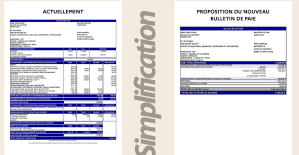If October is warm and fine, a sharp winter is coming. If only long-term climate predictions were that easy. Right now the question arises as to whether energy will be scarce in the cold season. The Helmholtz Vice President for Energy, Holger Hanselka, recently predicted that there would probably be no bottlenecks if the winter was mild. Which phenomena in Central Europe have an influence on winter, how seasonal forecasts work and how (un)certain they are.
What influences the course of winter in Central Europe?
A "bouquet of phenomena" determines what the winter will be like, explains climate scientist Klaus Pankatz from the German Weather Service (DWD). A phenomenon in the stratosphere above the North Pole plays a relatively large role: the polar vortex. This can influence the westerly wind circulation, which transports mild, humid air from the Atlantic towards Central Europe. If this circulation is impaired, cold air can reach us.
"When the polar vortex is unstable - which is a regular occurrence in winter - it disrupts the stability of the westerly wind circulation. This increases the likelihood of cold snaps,” says Pankatz. The good news: "At the moment, the polar vortex is very strong and stable for the foreseeable future."
In addition, the snow cover in Siberia and Central Asia has an influence on the course of the next winter. The climate scientist explains: “A high level of snow cover in early winter intensifies the Siberian cold high pressure area. It can spread further west in late winter and bring us cold easterly climates as a result.” In this general weather situation, continental air flows from the east to Central Europe.
How are seasonal forecasts made?
For seasonal forecasts, computers use a huge amount of data to simulate various possible weather scenarios based on special climate models. In this way, they calculate the probability that the coming season will be wetter, drier, warmer or colder than the long-term average. Relative statements are always made and absolute values such as specific temperatures are never given. "Seasonal forecasts are climate forecasts, not weather forecasts," explains DWD climate researcher Andreas Paxian.
What are the differences to the weather forecast?
Seasonal forecasts work with the "memory" of long-term processes, says Pankatz. The scientists' simulations relate to recurring and longer-lasting climatic patterns that extend over large areas. “When forecasting the weather, you look at individual days, such as their maximum and minimum temperatures. But as soon as you get beyond the period of ten days to two weeks, you have to start summarizing, averaging,” the climate scientist describes.
In the case of the seasonal forecast, it is a three-month average that is compared with that of the reference period. "On the seasonal forecast scale, it makes no sense to look at individual days." And that is exactly what is "important for the statement," emphasizes Pankatz. "If we say: There is a tendency for warmer conditions for the three-month mean, then individual days, weeks or even a whole month can be cold in this period."
Which data is evaluated?
For seasonal forecasts, the scientists work with an Earth system model. For this purpose, the earth is divided into three-dimensional grid boxes, in which the state of the atmosphere, the ocean, the land surface and the sea ice is described.
"I have to have observation points all over the globe with a certain spatial resolution at the height of the atmosphere and the depth of the ocean," describes Paxian. On the one hand, these are measured data and, on the other hand, calculated values for those parts of the earth system for which there are no measured data. In addition, assumptions about the concentration of greenhouse gases in the atmosphere are incorporated throughout the simulation.
How reliable are the results?
The scientists incorporate an enormous number of values into their simulation, some of which are based on extrapolations. "There's a lot of uncertainty, of course," says Paxian. For example, if the scientists only know the range in which a starting value lies, they let the model calculate with different values.
Another difficulty: We are far from familiar with all the processes and interactions between the atmosphere, ocean, land surface and sea ice. These are therefore not included in the current simulations. In addition, computers quickly reach their capacity limits when performing complex calculations. Paxian summarizes: "The quality of the prediction depends on which period, location and variable is considered."
And what is the current seasonal forecast?
The DWD scientists are currently evaluating data from various climate models for Germany. To do this, they calculate how many of the models have a proportion of warm, normal or cold results in relation to the respective reference period. The DWD itself compares for the period 1991 to 2020, other included models work with reference periods going back longer. Current status, according to Paxian: "For the three months - November, December, January - we see a slight trend for warmer conditions."
"Aha! Ten minutes of everyday knowledge" is WELT's knowledge podcast. Every Tuesday and Thursday we answer everyday questions from the field of science. Subscribe to the podcast on Spotify, Apple Podcasts, Deezer, Amazon Music, among others, or directly via RSS feed.

 His body naturally produces alcohol, he is acquitted after a drunk driving conviction
His body naturally produces alcohol, he is acquitted after a drunk driving conviction Who is David Pecker, the first key witness in Donald Trump's trial?
Who is David Pecker, the first key witness in Donald Trump's trial? What does the law on the expulsion of migrants to Rwanda adopted by the British Parliament contain?
What does the law on the expulsion of migrants to Rwanda adopted by the British Parliament contain? The shadow of Chinese espionage hangs over Westminster
The shadow of Chinese espionage hangs over Westminster Colorectal cancer: what to watch out for in those under 50
Colorectal cancer: what to watch out for in those under 50 H5N1 virus: traces detected in pasteurized milk in the United States
H5N1 virus: traces detected in pasteurized milk in the United States What High Blood Pressure Does to Your Body (And Why It Should Be Treated)
What High Blood Pressure Does to Your Body (And Why It Should Be Treated) Vaccination in France has progressed in 2023, rejoices Public Health France
Vaccination in France has progressed in 2023, rejoices Public Health France The right deplores a “dismal agreement” on the end of careers at the SNCF
The right deplores a “dismal agreement” on the end of careers at the SNCF The United States pushes TikTok towards the exit
The United States pushes TikTok towards the exit Air traffic controllers strike: 75% of flights canceled at Orly on Thursday, 65% at Roissy and Marseille
Air traffic controllers strike: 75% of flights canceled at Orly on Thursday, 65% at Roissy and Marseille This is what your pay slip could look like tomorrow according to Bruno Le Maire
This is what your pay slip could look like tomorrow according to Bruno Le Maire Sky Dome 2123, Challengers, Back to Black... Films to watch or avoid this week
Sky Dome 2123, Challengers, Back to Black... Films to watch or avoid this week The standoff between the organizers of Vieilles Charrues and the elected officials of Carhaix threatens the festival
The standoff between the organizers of Vieilles Charrues and the elected officials of Carhaix threatens the festival Strasbourg inaugurates a year of celebrations and debates as World Book Capital
Strasbourg inaugurates a year of celebrations and debates as World Book Capital Kendji Girac is “out of the woods” after his gunshot wound to the chest
Kendji Girac is “out of the woods” after his gunshot wound to the chest Skoda Kodiaq 2024: a 'beast' plug-in hybrid SUV
Skoda Kodiaq 2024: a 'beast' plug-in hybrid SUV Tesla launches a new Model Y with 600 km of autonomy at a "more accessible price"
Tesla launches a new Model Y with 600 km of autonomy at a "more accessible price" The 10 best-selling cars in March 2024 in Spain: sales fall due to Easter
The 10 best-selling cars in March 2024 in Spain: sales fall due to Easter A private jet company buys more than 100 flying cars
A private jet company buys more than 100 flying cars This is how housing prices have changed in Spain in the last decade
This is how housing prices have changed in Spain in the last decade The home mortgage firm drops 10% in January and interest soars to 3.46%
The home mortgage firm drops 10% in January and interest soars to 3.46% The jewel of the Rocío de Nagüeles urbanization: a dream villa in Marbella
The jewel of the Rocío de Nagüeles urbanization: a dream villa in Marbella Rental prices grow by 7.3% in February: where does it go up and where does it go down?
Rental prices grow by 7.3% in February: where does it go up and where does it go down? Europeans: “All those who claim that we don’t need Europe are liars”, criticizes Bayrou
Europeans: “All those who claim that we don’t need Europe are liars”, criticizes Bayrou With the promise of a “real burst of authority”, Gabriel Attal provokes the ire of the opposition
With the promise of a “real burst of authority”, Gabriel Attal provokes the ire of the opposition Europeans: the schedule of debates to follow between now and June 9
Europeans: the schedule of debates to follow between now and June 9 Europeans: “In France, there is a left and there is a right,” assures Bellamy
Europeans: “In France, there is a left and there is a right,” assures Bellamy These French cities that will boycott the World Cup in Qatar
These French cities that will boycott the World Cup in Qatar NBA: the Wolves escape against the Suns, Indiana unfolds and the Clippers defeated
NBA: the Wolves escape against the Suns, Indiana unfolds and the Clippers defeated Real Madrid: what position will Mbappé play? The answer is known
Real Madrid: what position will Mbappé play? The answer is known Cycling: Quintana will appear at the Giro
Cycling: Quintana will appear at the Giro Premier League: “The team has given up”, notes Mauricio Pochettino after Arsenal’s card
Premier League: “The team has given up”, notes Mauricio Pochettino after Arsenal’s card


















